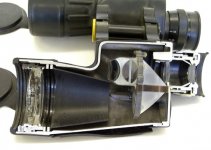Could you extrapolate on what exactly is an "extremely high contrast design"?
Bill
The most important component is a long, ribbed, tapered front tunnel,
which will actually appear to be a straight tunnel (the magnifying
effect of the objective makes it look 'straight').
A frequently-forgotten element is true flat-black 'flocking' coating the interior,
especially of the front tunnel. Matte-grey/black metal coating or
semi-gloss black plastic isn't the same, although some semi-gloss ribbing
has been given a rather ingenious assymetric 'ramping' that directs the light
outward over and over...that's fairly recent, or I should say,
recently revived for smaller binoculars. The ramped ribbing is
not exactly new...you can see it in the deep tunnels of the ~1970
Kowa Prominar. The Fujinons favor a slight 'parabolic shift' to the
tunnel that a multiple-reflection trace would show to throw the rays
forward. It's a similar ploy to foil multiple reflections, like
optical 'shark's teeth' (but pressing light out not in).
There is engineering behind these schemes.
The objective should be inset inward from the front of the binoculars, with
a flat black finish (common on armored binoculars) or a stepped outer
cap (older binoculars).
There can be an 'open-can' structure behind the front tunnel sometimes,
subtended by two irises and lined with flat-black flocked walls or parts.
That is extremely effective in conjunction with a decent front set-back.
The eyepiece should have a clean field-stop that steps in from the lenses.
Black edge-coating on the eyepiece elements is a bit obsessive, but
can add a bit more to saturation and deeper grey-level.
----------------------
There isn't any single thing. It's a 'dark concerto' of suppression layers.
The tunnel is the biggest piece, since a far wider swatch of light enters
than you look at. This went missing in many roofs and Porros for a while
and came roaring back a few years ago. Stubby-length binoculars
and xtra-wide-angle binoculars often don't have a decent tunnel, but they
cannot actually carry a good tunnel out in the distance allowed.
The sudden cutoff of the short tunnel is better in some cases.
Some small Bushnell Customs do actually continue the tunnel to the prism,
but they have extreme flocking and a following Barlow to help
both the contrast and the eye relief.
Last edited:





